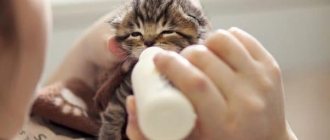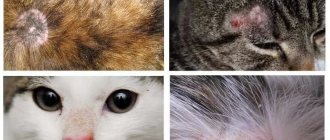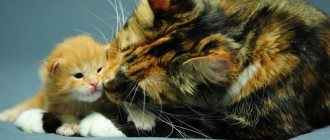Causes of the disease
New pet owners sometimes wonder: can a cat catch a cold? If some unfavorable factors coincide, this is very possible.
Most often, colds appear after hypothermia. Walking outside in bad weather (rain or snow, frost or strong wind) can also trigger a cold. The pet may be at home in a draft or, after active games, go into a room where the air is too cool.
Some owners wash their cats and do not pay attention to the water temperature. If it is cold, this will lead to hypothermia of the pet. And after bathing, the animal is generally very sensitive to the ambient temperature.
- I'm sick again!..
The body's resistance to various diseases depends on immunity. It may be weak due to poor nutrition or chronic diseases. A weakened and exhausted animal does not have the internal resources to suppress a cold.
Wool protects against small temperature changes. Hairless cat breeds, commonly known as hairless, are even more sensitive to changes in the environment.
Why does a cat get a cold?
Usually the disease does not occur on its own. Its appearance is facilitated by a large number of unfavorable factors that negatively affect the immune system and significantly weaken the animal’s body’s defenses. These include:
- Severe hypothermia of the individual. Colds are not only possible, but often occur in those pets who are outside for a long time when the air temperature is quite low. All this contributes to hypothermia, which cats can hardly tolerate.
- If the animal is kept in unsuitable conditions. Most often we are talking about damp, unheated rooms, the air temperature in which is below 20 degrees. This also includes constant drafts and the lack of an equipped place for the animal to rest. Frequent sleep on a cold floor is fraught with the development of the disease. A kitten's cold most often occurs for this reason.
- Unbalanced diet. In adults and kittens, low-quality food poor in nutrients leads to a deterioration in the functioning of internal organs and a decrease in the body's defenses. When the disease occurs, it can be extremely difficult for a pet to cope with it without additional drug treatment.
- Chronic and infectious pathologies. They weaken the body of cats and kittens, so if any unfavorable factors occur, the animal will not have the strength to resist a cold.
- A wet cat is forced to stay in a draft for a long time. Even if the owners carefully monitor the diet and living conditions of the animal, cat colds often occur in pets after bathing. It is very easy for a cat to catch a cold, especially if the owners do not restrict its movement throughout the apartment. A pet gets a cold when wet fur stops performing its warming function. Therefore, any slight draft can lead to illness in the animal.
The factors described above significantly undermine the health of your pet, therefore, to maintain his good health, you should try to reduce them to a minimum.
Even if the animal is sick, symptomatic treatment of colds in cats will help alleviate their condition as soon as possible and restore good health.
Symptoms and treatment
The signs of the disease are exactly the same as those that occur in humans - runny nose, sneezing, cough, loss of appetite. But such symptoms are also characteristic of many infectious diseases and allergic reactions. Therefore, if it seems to you that the cat has a cold and is sneezing, this is not a fact and it is better to show it to the veterinarian. He will prescribe tests and, based on the results obtained, make an accurate diagnosis.
Main symptoms
- Weakness – the pet doesn’t walk much, but may come up and inquire about the contents of the bowl. There should not be complete apathy.
- Discharge from the nose is viscous and translucent. They should not contain yellow or green impurities. The discharge does not interfere with breathing. If your pet constantly sits with its mouth open, then this is a sign of serious problems.
- Watery eyes – occurs due to irritation of the mucous membranes of the nose.
- Redness of the eyelids - appears due to increased blood pressure.
- Increased temperature (normal 38-39°).
Rarely do symptoms appear all at once, but the presence of 2-3 is already a reason to consult a veterinarian.
Tearing
Treatment
It is not always possible to go to a veterinary clinic. Treatment of colds in cats at home is possible, but at an early stage of the disease. Before choosing how to treat your cat for a cold, you need to carefully examine it.
First of all, the respiratory tract is cleared of secretions. The nose and eyes are carefully washed with a cotton pad. It is moistened in boiled water or herbal decoctions (chamomile or calendula are suitable).
The nasal passages are washed with a 0.5% Tannin solution. A small amount of the mixture is carefully dropped into the nostrils. It is convenient to do this with a pipette or enema. You can instill a mixture of 1% Methanol with fish oil.
When the temperature rises, antipyretic drugs are required. Dosage and specific names should be checked with your veterinarian. Human medicine should not be given.
The animal needs to be provided with a comfortable and warm place to rest. Do not let your pet lie on a cold floor (tile, linoleum).
You can place a heating pad covered with a blanket next to the cat. This warming will increase blood circulation. Food and water should be at room temperature. Additionally, they give your pet vitamins - they help replenish the lack of nutrients in the body and improve immunity.
Treating cat colds with medications
If you cannot stabilize the animal’s condition on your own, you will need to take medications. It is important to remember that only a veterinarian can treat colds with medications in cats. Tablets and drops intended for humans may not only not have any positive effect, but also worsen the pet’s condition. In addition, it will be extremely difficult for a small individual to find the right dosage, even if medications intended for children are used.
Depending on the severity of the disease, the animal is prescribed antiviral drugs and nasal rinsing drops; if the cat has a fever, an antipyretic. When your pet has a cough or wheezing in the lungs, an expectorant will be needed. If a secondary infection occurs, you may need to take antibiotics in the form of tablets or injections, or administer fortified solutions to support the immune system. In severe cases, the veterinarian prescribes drips to relieve intoxication.
The selection of medications for a cat in the treatment of colds is carried out only after an initial examination, collection of anamnesis and receipt of the results of clinical studies, such as blood and urine tests. All these measures will allow you to establish an accurate diagnosis and prescribe adequate therapy, because the symptoms characteristic of a cold are also characteristic of other cat diseases, for example, rhinotracheitis, mycoplasmosis or pneumonia.
Possible complications
A cat's cold is not transmitted to its owner, but the disease can spread to other animals in the house. In the absence of timely treatment, there is a possibility of complications developing.
First of all, it is bronchitis, pneumonia, tracheitis. These are serious diseases that affect the lungs, bronchi and trachea. They are severe and can be fatal.
Colds in cats with good immunity go away with minimal symptoms and are easily treated. In some cases, it seriously weakens the body, significantly reduces immunity and disrupts the functioning of the genitourinary system. Due to weakened immunity, susceptibility to various infections increases.
- This is problem…
What could be under the guise of a cold?
Symptoms of a cold can be similar to those of other diseases. Rhinotracheitis is caused by herpesvirus type 1. It can be transmitted both by contact and by airborne droplets. The pathogen can be carried on shoes or clothing.
Distinctive signs of rhinotracheitis are difficulty swallowing and the appearance of a white coating on the nose. Small ulcers appear on the lips and cornea of the eyes. The animal has difficulty swallowing food and water. The nasal discharge becomes thick and mixed with pus. After some time, the disease goes away on its own, but after it the animal acquires chronic eye diseases or a runny nose.
The common cold can be confused with calcivirus - it is transmitted through contact with a sick individual or carrier. The disease is characterized by the appearance of ulcers on the roof of the mouth, nose and tongue. To make a diagnosis, a mucosal smear will be required.
Correct identification of the disease allows you to prescribe the right treatment. Therefore, you should not neglect examination by a veterinarian and testing. If there is a delay, the death of the animal cannot be ruled out.
How to treat a cat for a cold: helping a cat at home
If the disease progresses calmly, the pet can be treated at home. Therapy involves comprehensive relief of symptoms, alleviation of the general condition and stopping the progression of the infection. Before treating a cold with medication, follow these steps and monitor your pet for 12 to 24 hours.
- Place the animal in a dry, ventilated area.
- Provide your cat with a warm drink, preferably milk.
- If the animal is cold, cover it and make a heating pad.
- Give the animal a massage from the limbs to the body; if the cat does not like such procedures, just pet it - this will increase blood flow and help the body fight.
“Home” symptomatic treatment is allowed at the stage of a runny nose and increased lacrimation; the cat must be helped to clear the airways, for this:
- We clean the nose and eyes of secretions with a moistened cotton sponge. Wet the sponge in clean water; do not use herbal infusions unless you are sure that your pet is not allergic.
- We rinse the nose with the solution, choose one of the options: Adrenaline novocaine 1%;
- Tannin 0.5%;
- Ethacridine 0.2%;
- Zinc sulfate 2%.
- We instill the nose with a special veterinary medicine or a mixture of fish oil and methanol 1%.
- We try to place streptocide powder in the nostrils, but the cat really doesn’t like it.
If the condition worsens and a cough appears, antibiotics for cats for colds are relevant. If you are not a doctor, it’s better to decide what to treat after consulting a doctor. If you don’t have the opportunity to go to the clinic, call, but don’t make a random choice, especially don’t treat the animal with your own medications.
As a rule, the main and probably the main reason for the development of colds in animals is hypothermia. As a result of exposure of a cat's body to low temperatures, its general condition changes.
The severity of these changes depends on the degree and duration of exposure to cold on the pet, as well as on the degree of perfection of the natural thermoregulation mechanism responsible for the production of heat in the body.
Most often, severely weakened, overtired, exhausted animals, as well as those that have suffered heavy bleeding, serious illnesses, etc., suffer from colds.
Various factors affecting the animal’s body can lead to a cold in cats. These factors include:
- Violation of feeding regime. Proper and nutritious feeding is the key to excellent cat health. If the feed contains a sufficient amount of vitamins, minerals and essential nutrients. then the pet will be able to avoid most cat diseases.
- Infectious diseases lead to a decrease in the body’s protective functions and a weakening of the immune response to the introduction of opportunistic microorganisms.
- Unfavorable living conditions - keeping a cat in a damp, poorly heated room causes colds and accompanying pathological changes in the body. So, a comfortable temperature in a room for a cat during the cold season is considered to be no lower than 20-22 0 C. This fact must be taken into account in the off-season, when there is no heating in the apartments, and provide the animal with a warm bed, for example, near a heating device. It is better to use a flannel diaper or a warm blanket as bedding, which will help the cat warm up and keep its health in perfect condition.
- Unfavorable environmental conditions - sharp wind, rainy or snowy weather, high humidity increase the harmful effects of low temperature on the cat's body when it is outdoors.
- Prolonged stay of a wet animal in a draft. A cat can get into a draft immediately after taking a bath. Therefore, a bathed pet must be thoroughly dried with a terry towel, which absorbs water well, and sent to dry in a warm room with the windows closed.
- Hypothermia of an animal during a walk in the fresh air in the cold season. To avoid these problems, it is better to walk the cat, if this is the practice of the owners, in autumn and winter, in a dosed manner and for a short period of time.
We invite you to read: Milbemax for cats: instructions for use
A cold in all warm-blooded animals, including cats, is preceded by a compensatory reaction. But the longer the cold lasts, the more the thermoregulation mechanisms are disrupted. As a result, hypothermia occurs, body temperature decreases, and the functions of some body systems are disrupted.
It would seem that, at first glance, such a mild illness in a cat as a cold, in the absence of therapeutic measures, quite often leads to the development of other more severe conditions: inflammation of the lungs and bronchi, the development of kidney disease, and inflammatory diseases in the joints.
As a result of a cold, cats' immunity decreases and the body's natural resistance to infectious diseases decreases.
If in an animal with a good immune system, contact with any microbe or virus will not cause serious health problems and will go almost unnoticed, then in a cat with frequent colds, the same microorganism will cause a severe pathological process.
Signs
As mentioned at the beginning of the article, the main signs of a cold in cats are:
- runny nose,
- hot and dry nose,
- lacrimation,
- slight increase in temperature,
- sneezing,
- fast fatiguability,
- lethargy,
- lack of appetite or decreased appetite.
If these signs are detected, a loving cat owner should not hope for the pet to recover on its own. First of all, a person must make sure that it is really a cold and not some other viral or bacterial disease with similar symptoms or an allergy.
But even with confidence in the etiology of the disease, a cold must be treated with complete seriousness and responsibility, so that it does not develop into another more serious form.
How to treat
When treating a cold, you must first take the following general measures:
- provide your pet with peace and quiet;
- place the cat in a warm, well-heated and dry room;
- provide the animal with a warm drink, for example, regular warmed milk;
- you can use warming compresses or heating pads (the easiest way is to use self-heating saline);
- When there is no heating in the apartment, the most common heaters are used to maintain a comfortable temperature in the room. The main thing is to ensure that the animal does not get burned if it accidentally comes into contact with the hot surface of the heater. It is better to place the heater in a place inaccessible to the cat so that it cannot reach it;
- A regular massage gives a good effect for colds; it is enough to stretch the animal’s body well. As a result of these manipulations, blood flow in the superficial vessels of the skin will increase, the cat will warm up faster after cooling, and the healing process itself will go much faster.
Symptomatic treatment is used as general therapy. If there is a runny nose or discharge from the eyes, special drops are used.
If the process is aggravated by cough and other cold symptoms, it is advisable to prescribe antibiotic therapy to suppress the growth of pathogenic microflora and stop the further development of inflammatory processes.
Prevention measures
Proper care of your pet can minimize the risk of developing diseases. A balanced diet and compliance with sanitary standards allows you to maintain your cat’s immunity at the proper level.
Pets are sensitive to stress. Therefore, at such moments, plant-based sedatives can be given.
To prevent colds, wrap your cat in a dry towel after washing or being exposed to rain. Drying should take place in a warm room without drafts. If the pet calmly accepts the hair dryer, then the drying process can be accelerated with its help.
In cool and humid weather, you should stop walking outside.
A decrease in immunity can occur due to infection with parasites. Therefore, all animals must be regularly treated with anthelmintics.
In order to reduce the likelihood of rhinotracheitis, vaccination is done. It is carried out once a year at a veterinary clinic. The vaccine is inexpensive and provides good protection.
Feed
For nutrition, cats use food ranging from premium to holistic. They have a balanced composition, which includes not only nutrients, but also essential vitamins and minerals.
If the owner is a follower of natural nutrition, then the cat's diet should consist of raw meat, a small amount of vegetables and vegetable oil. If necessary, additional supplements with minerals and vitamins are given.
Main signs of a cold
Normally, cats do not get colds; their immune system successfully fights viruses even in old age. However, there are a number of circumstances that can significantly weaken the immunity of a purring friend:
- Violation of maintenance standards - dampness and drafts are the most common causes of colds in pets. High humidity in the room can lead a pet to pneumonia, and the disease process is so gradual that the owners are late in realizing the seriousness of the problem.
- Poor nutrition - a constant deficiency of vitamins that occurs with a monotonous or poor-quality diet leads to a decline in immunity.
- Violation of the temperature regime - cats react sharply to “jumps” in the temperature in the home; the optimal range is considered to be 18–20 °C in the warm season, 22–24 °C in the cold season.
- Hypothermia – freedom-loving cats walking outside can get caught in the rain. When the animal gets very wet, its thermoregulation is disrupted and the pet freezes in a matter of seconds, especially if it is in a draft. The same goes for bathing - poorly dried wool can cause illness.
- A hidden disease - an asymptomatic pathology can “draw” the strength of the immune system onto itself, depriving the pet of protection from an elementary cold.
Particular care must be taken during the winter months. If your pet is actively “occupying” radiators and heating devices, take action. Arrange a bed for the animal that is located far from the floor, if the dimensions of the home allow - in the kitchen. For bedding, use an old terry towel, blanket or any fabric that retains heat.
Now about the main thing, how to distinguish a cold from other diseases. From the side of cat physiology - a hot and/or dry nose, deterioration of the coat, ignoring toys and rewards from the owner, prolonged sleep, aggression or fearfulness towards other animals. Signs of a cold in cats are often confused with symptoms of more serious diseases, so let’s look at the issue in more detail. The symptoms of the disease are very similar to those in humans:
- Weakness - within reason, the cat should leave its sleeping place and stand firmly on its feet. Fatigue is normal, complete apathy most likely indicates more serious reasons.
- Snot is a discharge from the nose, this is a normal and healing process during a cold; dead leukocytes and microorganisms are removed from the body with mucus. During a runny nose, a cat may have difficulty breathing through its nose, so it opens its mouth slightly; breathing exclusively through the mouth is a dangerous symptom. The discharge should be transparent with little viscosity. If the discharge changes color, completely blocks the airways of the nose, or becomes purulent, it’s not a cold! To the vet!
- Sneezing and coughing are natural processes to clear the airways. The cat sneezes and washes itself - everything is within normal limits; if its face is dirty with matted hair, the disease is progressing or has a pathological cause.
- Watery eyes may occur as a result of increased irritation of the nasal mucosa.
- Lack of or decreased appetite - a cold can suppress a cat’s appetite for several days, while the animal sometimes drinks more than normal. There is no point in “persuading”, much less forcing, to eat; the animal knows its body better than any doctor. Maximum - offer the cat low-fat broth. If the animal refuses to eat for more than 32 hours, call your veterinarian, describe the symptoms and together decide how to proceed.
- Redness of the mucous membranes is an optional symptom and is extremely rare in cats of “noble” breeds. However, reddened eyelids may indicate increased blood pressure, which is a separate symptom.
- Increased base body temperature – cats do not have a stable body temperature. Even a healthy pet can change its temperature during the day by 0.5–1 °C; depending on the size and breed, the base value can range from 37.5 to 39 °C. The temperature of hairless cats is no different from wool cats, although they may seem hotter to the touch.
The presence of one or more symptoms from the list is already a reason to be wary and monitor the dynamics of your pet’s condition. If you have the opportunity to immediately show your pet to a veterinarian, do so; the earlier the disease is diagnosed, the easier it is to treat.
Rhinotracheitis is an acute disease of the eyes and nose, accompanied by copious adhesive discharge. Only cats that have recovered from the disease have immunity.
Pneumonia is diagnosed by a regent and by listening to the chest.
Mycoplasmosis and other infections affecting the genitourinary system and mucous membranes.
Calcivirosis is an acute infectious disease. Accompanied by conjunctivitis and the appearance of ulcers in the mouth.
FIP - infectious peritonitis is a very serious disease with many strains that affects almost all vital systems of the animal. At first, severe weight loss, irritation of the mucous membranes, lacrimation, jaundice, kidney failure, and clouding of the cornea are observed.
Panleukopenia (distemper) is a deadly disease that causes purulent discharge from the nose and eyes.
Pets suffer from the same diseases as humans. Therefore, a cold in a cat is a common, easily identified phenomenon. However, the disease in pets is more complicated.
This causes a lot of problems for the animal and the owner. the danger lies in the possible spread of infection to other organs.
Therefore, it is important to know how to identify a cold and help your pet so that serious complications do not develop.
If everything is fine with the pet, then the cold rarely overcomes. The immune system successfully fights viruses and bacteria that enter the body, even in old age. The disease develops only when exposed to negative factors, when the immune system begins to weaken. Let's look at the 5 most likely reasons:
- Mistakes in creating living conditions. Constant drafts or increased dampness in the apartment often lead to the pet getting sick. Keeping an animal in a damp room for a long time increases the chances of developing pneumonia.
- Incorrectly formulated nutrition. You will need to approach feeding your pet responsibly. A constant lack of minerals and vitamins leads to a weakening of the immune defense.
- Failures to create optimal temperature conditions. Cats are extremely sensitive to temperature changes. In the cold season it is better to keep it at 22–25 degrees, in the warm season – 18–21.
- Hypothermia. If a cat likes to go outside, it may get caught in the rain and get very wet. In the animal, this leads to disruption of thermoregulation, so instant hypothermia occurs. The same reaction occurs from bathing without thorough drying.
- Invisible course of the disease. The disease, which occurs without visible symptoms, slowly deprives the body of protection against colds.
Before treating a cat for a cold, it is necessary to find out and eliminate the factor that led to the painful condition. Therefore, it is so important to know about the listed reasons.
Whether a cat can catch a cold from a person is a question that concerns every owner. Although animals suffer from the same diseases, these conditions are caused by different viral agents. Therefore, the cat is unlikely to become infected. However, this does happen sometimes. One of the reasons is that the disease was caused by bacteria, which is rare.
Now the question is: “Can a cat catch a cold from a person?” is still being studied. This is associated with the emergence of new mutated viruses, which opens up ways for transmission from humans to animals and vice versa. This leads to the fact that pets have become more difficult to treat.
We suggest you read: Increased protein in the urine of a cat, assessment of test results. Increased protein in the urine of a cat, causes of proteinuria.
— Expert advice! To reduce the likelihood of pathogen transmission from owner to pet, precautionary measures must be taken. The main thing is not to pick up your pet during illness and to minimize any contact.
Cold symptoms
Nasal discharge is the first identifying symptom, which is considered normal, since microbes and dead white blood cells come out with mucus. A runny nose in cats is accompanied by difficulty breathing. The norm is to inhale together through the nose and mouth.
If a cat breathes only through its mouth, what does this indicate the seriousness of the disease. Nasal discharge is usually clear and liquid. A change in the texture or color of the discharge is a dangerous symptom that requires urgent intervention.
If your cat has a cold, treatment at home will make it possible to quickly return your pet to a healthy state. This is allowed only for mild cases of the disease.
It is worth starting treatment without the use of medications, observing changes in well-being. If everything is fine and the animal is recovering, then there is nothing to worry about.
First events:
- place your pet in a dry room with good ventilation;
- ensure peace, eliminate stress factors;
- place a drinking bowl with warm water nearby;
- wrap it in a warm cloth or put a heating pad if the cat is cold;
- massage the limbs, stroke them to disperse blood throughout the body.










